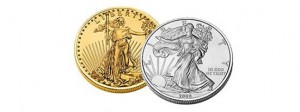The Hydraulic Press

Hydraulic presses are used in production facilities around the world for the manufacturing of many different metal parts. These include auto parts, shelving, medical equipment, and even punching and stamping of coins. A hydraulic press works by using hydraulic pressure to press material in between upper and lower plates or dies. These dies and press plates are specifically designed to form or stamp usable parts out of sheet metal, strip metal, and other metal workpieces.
Hydraulic presses are capable of applying tons of pressure to material, making it almost effortless to form or punch the part very quickly.
How Hydraulic Presses Are Used In The Coining Process
When it comes to manufacturing coins and tokens, hydraulic presses are used in a couple different ways. Typically, the silver, gold or copper will be processed into a thin strip, using other machinery. It is then annealed to bring the metal strip to the target hardness for the coin stamping process.
This strip is then inserted into the hydraulic press, which is equipped with specific diameter circular dies that fit into one another. Once the machine tool is activated, the top die will be pressed into the bottom die very quickly with tons of force — resulting in one or two blank coins being pushed through, onto a table or conveyor belt below.
These blank coins or tokens are then inspected, weighed and sometimes burnished to give the surface a rough appearance. Now, it’s time for the final press process, which is used to stamp rather than punch.
This process, commonly referred to as coining, begins by placing the blank coins or tokens into the bottom die. The bottom die will have circular indents the exact diameter of the blanks. Once the machine is activated, the top die will move downward quickly, making contact with the blank. Enough force is used to press the image of the dies into both sides of the coin simultaneously.
Now, this part of the stamping or coining process is also applicable in other industries such as the remanufacture brake shoes, for example. This process involves placement of the parts(s) into the press, which forms the top and bottom, according to the design of the dies. This happens simultaneously, once the machine is activated. The only major differences are the tonnage required to properly form the parts and the dies used, which are specific to the parts being formed.
New Hydraulic Coining Press
Greenerd Press & Machine Company, Inc recently manufactured a 1,000 ton hydraulic coining press with unique design traits aimed at reducing cycle time while improving part quality. This automatic press was designed for and is being used by Global Parts Networks, LLC (GPN) to remanufacture brake shoes.
This new machine tool is equipped with a 36” x 36” bed and adjustable stroke of up to 12”. It is a straight side 8-point gib guided hydraulic press with pressing rates up to 23” per minute.
The company is quite satisfied with the new custom designed machine, as it has proven reliable while significantly improving the efficiency and quality of produced parts. Finding the perfect hydraulic press for the parts being manufactured is important. It does not always take having a custom machine being built in order to properly form parts, but when efficiency and quality are important, a custom built machine tool such as this can definitely help.